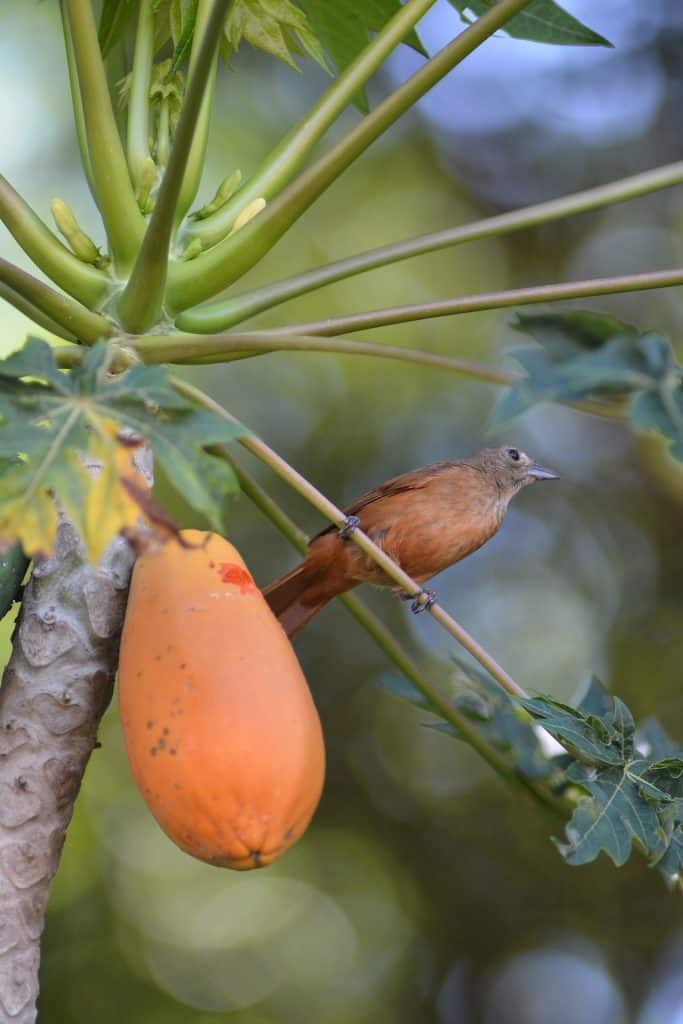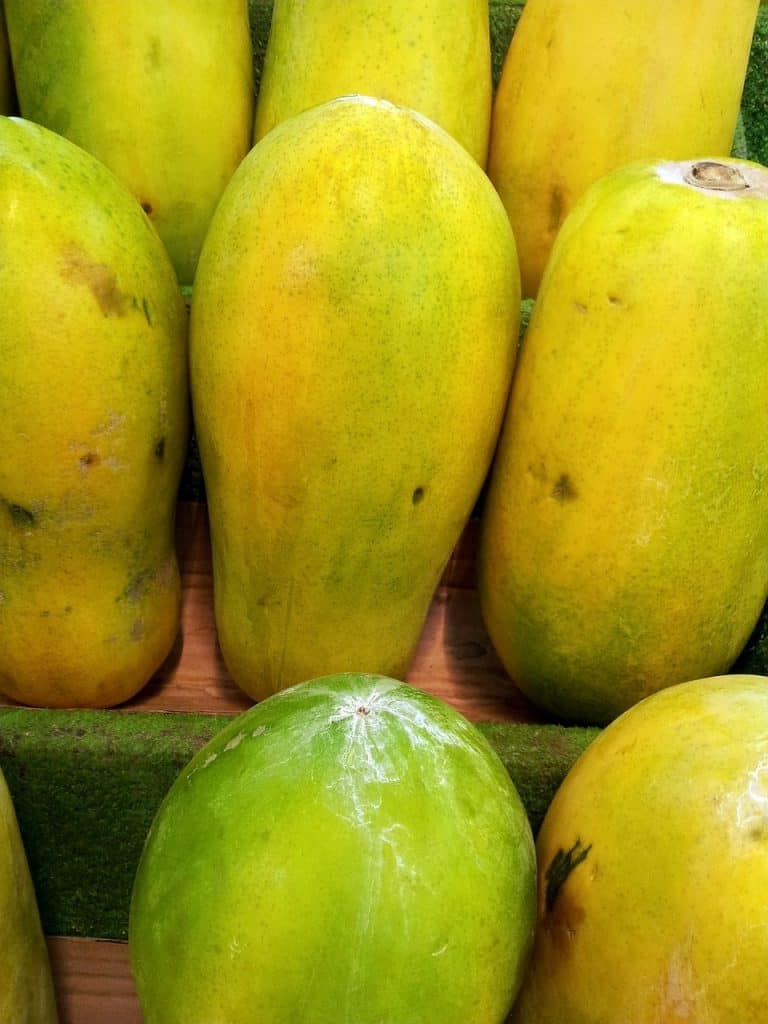As an Amazon Associate we earn from qualifying purchases.
My parents grew up in Hawaii, so even when they moved to California, tropical fruits were still fairly common around the house. One that I always underappreciated was the papaya. I remember I’d always do simple preparations like papaya cut with lime juice or with cottage cheese or yogurt.
When I got older, I learned to love papaya, especially in smoothies! Papayas can be tricky fruits though, as they seem so foreign. How do you tell when they are ripe? How do you pick a good papaya? When are they starting to go bad? I’ll be going over everything you need to know about how to pick the perfect papaya.
Quick Navigation
What Is Papaya?
Papaya is a sweet tropical fruit believed to have originated in Central America. It has a sweet and musky flavor and is generally enjoyed raw. The luscious fruit is a large, oval-shaped fruit with yellow, orange, or red flesh.
Inside the delicious papaya is a cavity filled with tiny, round, black seeds that are edible when ripe. Papaya is high in antioxidants, vitamins A and C, and is a good fiber source. It’s eaten as a snack, used in juices, salads, and smoothies, or cooked in savory dishes.
How to Pick a Papaya
There is no secret about how to pick a papaya. By looking at the color, skin, and smell you will be able to tell if your papaya is ready to enjoy.
Know the Variety You Want
There are literally dozens of varieties around the world. The two most common varieties of papaya in the United States are:

- Mexican Red and Yellow papayas
- Hawaiian Sunrise / Strawberry papayas
I’ll only be discussing the most common varieties you can find in your local supermarket.
Mexican Red Papayas and Mexican Yellow Papayas
These papayas are the bigger of the two main types growing well past 12 inches in length and weighing over 3 pounds. They are cylindrical in shape with a slight taper on the stem side. Color wise, these papayas are sold with green yellow to yellow colored skin.
In San Diego where we live, they are by far the most popular and prominent variety sold in my stores. In the rest of the country, you should see a more normal split between Mexican and Hawaiian varietals.
Mexican red papayas have a red-orange flesh (the part you eat). Mexican yellow papayas have a yellow-orange flesh and are slightly sweeter. The flavor of the Mexican papaya (especially the red one) is more subtle and muskier than that of the Hawaiian varieties.
All Mexican papayas make great additions to peach fruit salads and freeze really well for green smoothies, sorbets, ice creams, and the like.
Hawaiian Sunrise Papaya also known as Strawberry Papaya

The Hawaiian Sunrise Papaya is also known as a Strawberry Papaya. This is the smaller of the two main varieties you will see in your local supermarket. Strawberry papayas are the shape of a small football to a large pear.
They have green to yellow skin and reach roughly 1 pound in size. Their flavor is definitely sweeter than the Mexican variety but still with relatively subtle flavor. Strawberry papayas have very little musky flavor, unlike the larger Mexican Reds.
Overall, papaya is really good for mys health and even for dogs. You can add this tasty treat to their meal aside from their usual dog food. Since it is rich in fiber and healthy enzymes, it can improve your dog’s digestive health.
Look at the Color
Color is the main signal for ripeness when it comes to papayas. Color change helps signal to birds and other animals it is time to eat the fruit and spread the seeds. Papaya are very much like bananas. They are picked green and ripped in transport to their final destination.
When they get to the store they are moving in the yellow direction. Here’s what to know about the colors:
- A fully yellow papaya is ready to eat
- A yellow orange papaya is heading into overripe territory but is still edible
- An orange papaya is almost certainly overripened
Examine the Texture
The texture of the skin won’t really tell you if a papaya is ripe but it will tell you if it is bad. Any black spots, sunken spots, white specs, cuts, or bruises are a no go.
Smell the Papaya
Much like a pineapple, you can smell the ripeness of a papaya. You are looking for a melony scent with no hints of mold.
Squeeze the Papaya
The common convection for testing if a papaya is ripe is to gently squeeze the skin. If the papaya gives slightly under pressure it is ripe.

While this does reliably work to tell if a papaya is ripe, too often will you find papayas in the store with black or moldy finger print size depressions. Unless you are planning on eating the papaya the day you buy it, I recommend buying a green yellow papaya and to finish the ripening at home.
Look for Mold
Papayas are notorious for mold. Papayas are giant tanks of water and sugar but without the hard shell of their melon cousins. All that goes to say that papayas are ideal homes for molds to grow and thrive.
When you buy a papaya you do not want to see dark spots, sunken spots, or cuts in the skin, all of these are prime targets for mold to grow. Again a papaya is not a melon – damage to the skin will lead to mold growth.
How to Choose and Use Green Papaya
Green papaya is a versatile fruit used in various recipes. When selecting green papaya, look for one firm with no tender spots or bruises. The skin of the papaya fruit should be a light green color, and the flesh should be a light yellowish-green.
When preparing green papaya, you can boil, fry, or consume it raw. Boiled green papaya is a part of salads, soups, and stews. Fried green papaya can be a side dish or used as an ingredient in a stir-fry. Pregnant women should be cautious when consuming unripe papayas.
Grate raw green papaya for salads or as a garnish. Green papaya also makes paste used as a condiment or a dip. (Note: Putting papayas in a paper bag or sealed container with fruits that release ethylene speeds up ripening. You can increase the ripening process using an apple)
How to Cut and Eat Ripe Papayas
Before enjoying this fruit’s health benefits, you must slice open the ripe papayas. Here’s how to do it:
- Start by washing the ripe papaya with soap and warm water, then dry it. Washing it first helps to remove any dirt or bacteria
- Using a sharp knife, cut the papaya in half lengthwise and scoop out the seeds (Use a wooden cutting board or any flat surface for this). Place the seeds onto a plate. Cutting it in half and scooping out the seeds makes it easier to peel and slice.
- Cut the papaya into pieces of the desired size.
- Peel off the skin using a paring knife.
- Slice the papaya into thin pieces or cubes. You can combine your papaya with other fruit in a fruit salad.
- Place the sweet papaya pieces on a plate and enjoy!
- To freeze the papaya, place the cut pieces on a baking sheet and freeze for about an hour or until frozen. It is stored in the refrigerator fresh for up to 3 weeks.
Where Can You Buy Papaya?
You can buy papaya at grocery stores, supermarkets, farmers’ markets, and online retailers. Papaya comes fresh or frozen; depending on the season, it is available in various shapes and sizes.
Some specialty stores may carry processed papaya products, such as juices and jams. In some countries, a papaya tree is a common feature of many home gardens. This allows for an even fresher and more affordable supply of fruit.
Why Does Papaya Smell Bad to Some People?
Papaya has a distinct and strong smell that can be off-putting to some people. This is because of the presence of the enzyme papain. Papain gives the fruit its robust and musky smell.
Add lime juice over your cut papaya to give it a burst of flavor and remove any unwanted odors.
Related Questions
How Can You Tell if a Papaya Is Ripe?
A papaya is ripe when the underlying flesh is soft to the touch giving to gentle pressure. While color is the signal a papaya may be ready to eat, a pressure test will definitely yield more definitive results.
Can You Pick a Green Papaya?
Yes, you can pick a green papaya. Fully green papayas are immature though and will never ripen to the same state as their yellow counterparts. One of the most famous dishes from Southeast Asia is green papaya salad, and it is delicious.
Conclusion
The next time you are out looking for a papaya, ask yourself when you want to eat it. The short term shelf and fridge life of the papaya means it must be treated more like a banana than a melon.
If you are hoping to enjoy your papaya today or tomorrow morning for breakfast aim for an entirely yellow specimen. If you want to save your papaya for the weekend, aim for a green-yellow one and ripen it at home.
